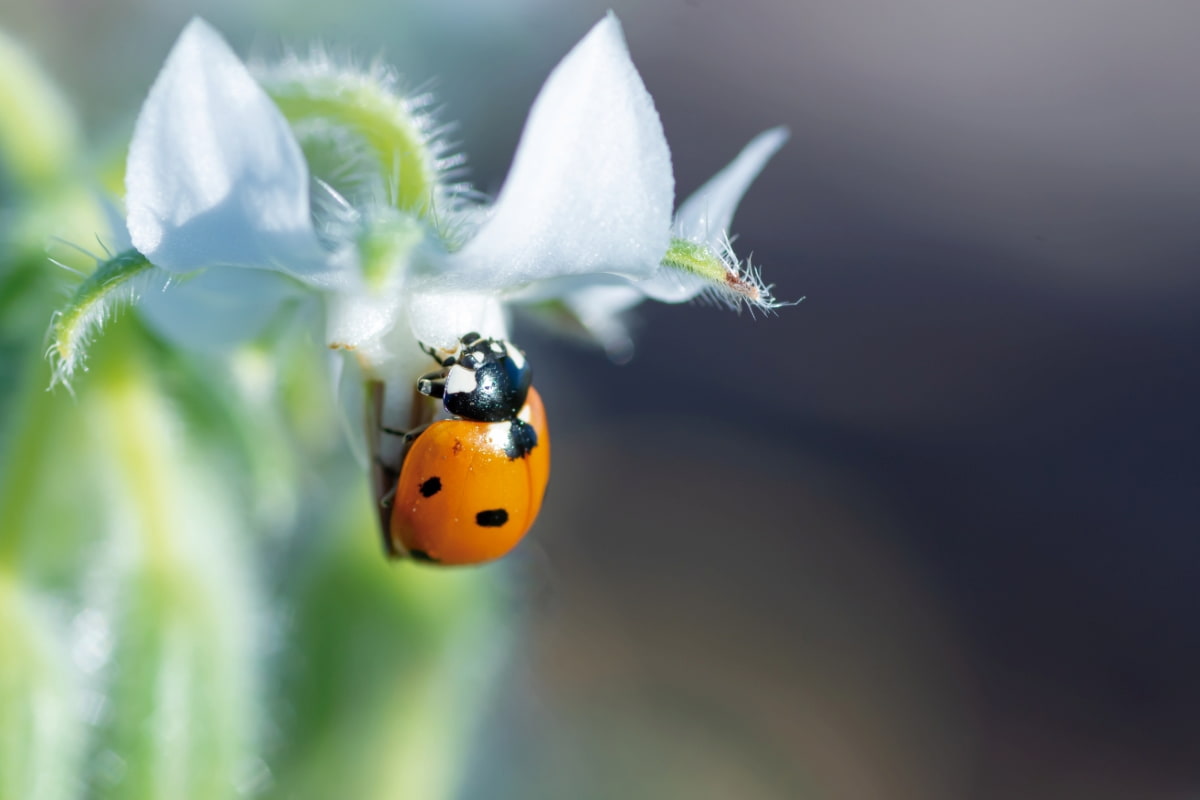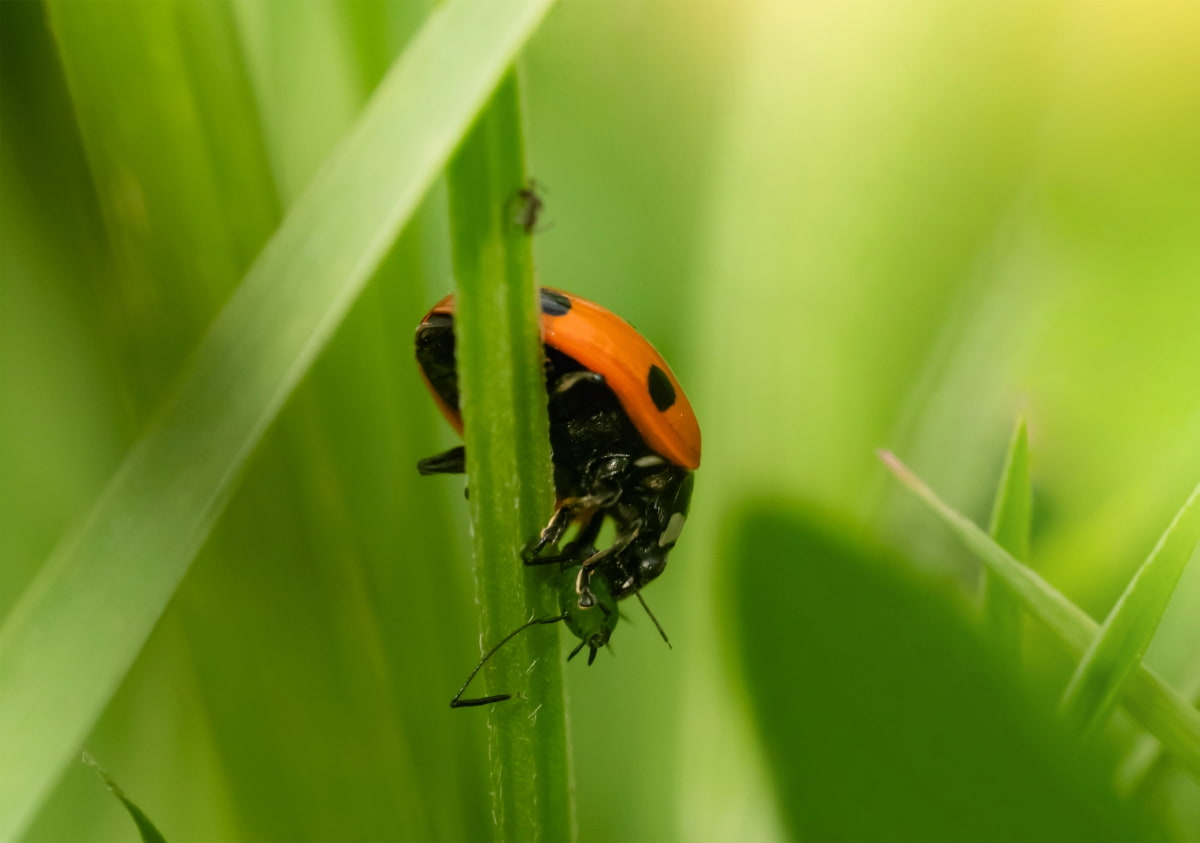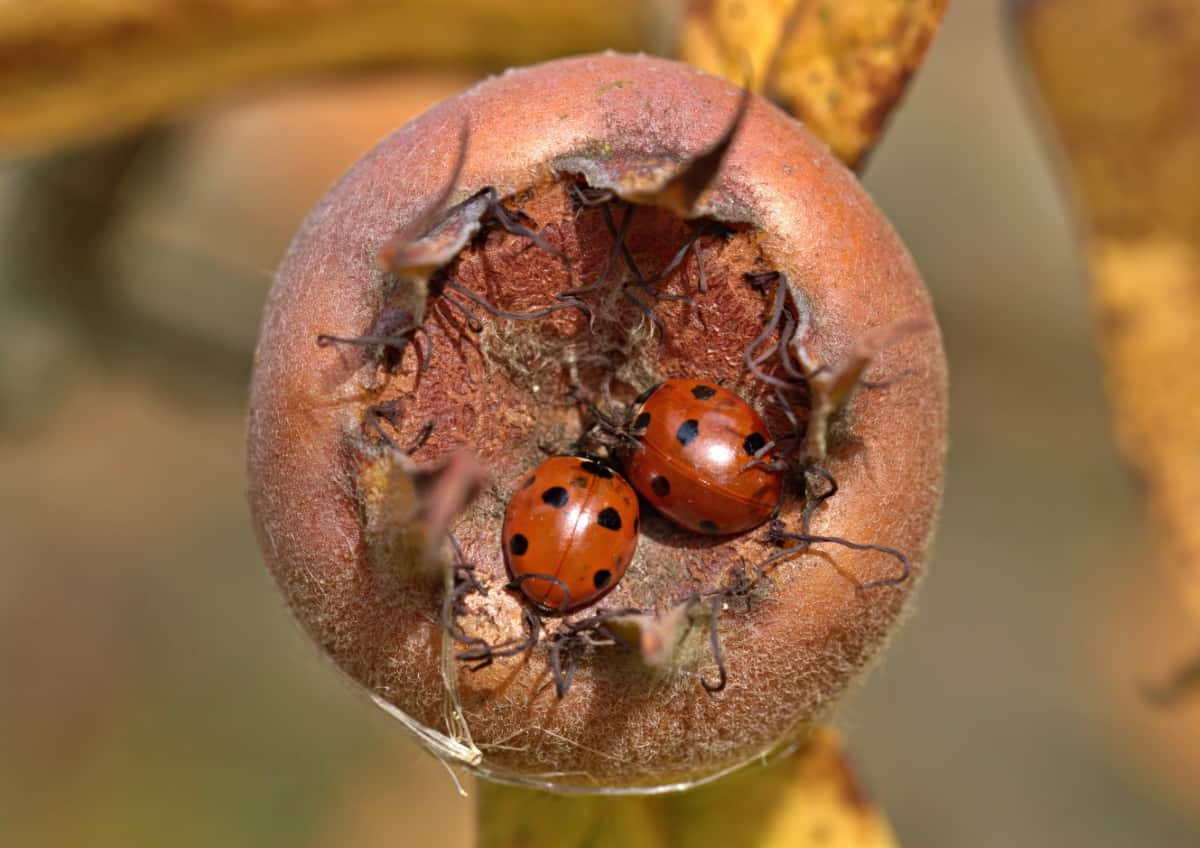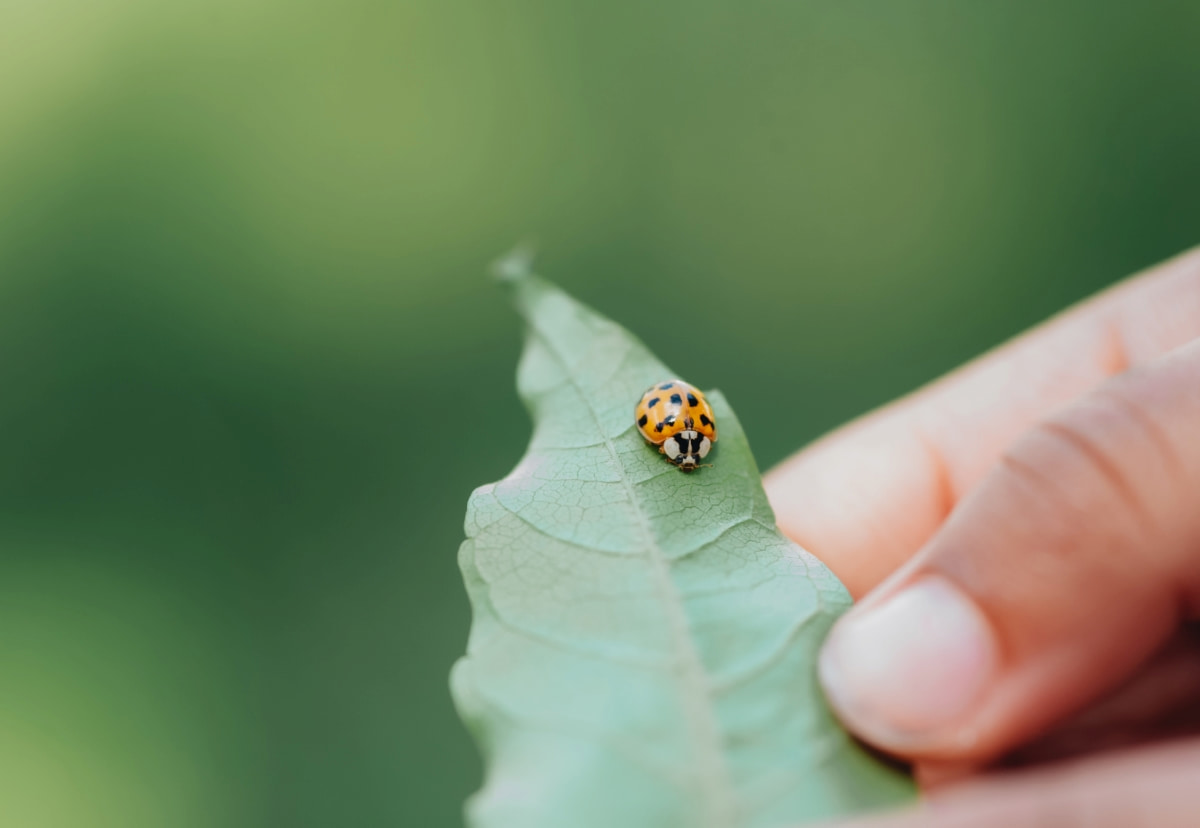Take a fascinating trip into the fascinating world of ladybugs, those endearingly spotted insects. We examine their selective feeding practices in this enlightening blog, delving into the factors that feed these little yet ferocious predators. Learn about the varied diet of ladybugs, which includes plant materials and aphids, and how it affects their surroundings.

What Do Ladybugs Eat
Aphids: A Staple in Ladybugs’ Diet
Aphids, little sap-feeding insects, play a vital role in the nutritional needs of ladybugs. Because of their high nutritional value, ladybugs perceive these little insects, which are often found in groups on plants, as a very nutrient-dense food source. Ladybugs are essential for regulating aphid populations in gardens and agricultural environments, thus limiting the harm that aphids may inflict on plants.
Aphids undergo fast reproduction, giving them a plentiful and readily available source of sustenance for ladybugs. The predator-prey dynamic between ladybugs and aphids is crucial for the survival of ladybugs. It has a positive impact on the environment by regulating aphid numbers and promoting plant health. To summarize, aphids play a vital role in the diet of ladybugs, contributing to their survival and helping to maintain ecological balance.
Scale Insects: Another Favorite Meal
Ladybugs, renowned for their voracious consumption of aphids, also often devour scale insects, which are another kind of plant-insect. Scale insects, known for their sap-feeding behavior, often cause harm to both crops and ornamental plants. Ladybugs, being natural predators, aid in the regulation of these pests.
Adult ladybugs and their larvae consume scale insects, aiding in integrated pest control in agricultural and garden settings. This feeding habit not only lowers the use of chemical pesticides but also maintains ecological stability. Gaining insight into the varied dietary habits of ladybugs, which include their consumption of scale insects, is essential for effectively using their function in natural pest management.
Mealybugs: A Nutritious Option
Mealybugs, tiny arthropods with delicate bodies, are a crucial component of the ladybugs’ dietary preferences. These pests, often found in gardens and houseplants, provide vital nutrition for ladybugs. Ladybugs, renowned for their discerning dietary preferences, have a strong preference for mealybugs owing to their elevated protein levels and convenient availability.
Ladybugs are beneficial for gardens and crops because they naturally suppress mealybug infestations. The interplay between ladybugs and mealybugs exemplifies biological pest management, illustrating nature’s mechanism for preserving equilibrium. Ladybugs play a crucial part in agriculture and gardening as helpful insects by feeding on mealybugs, which not only provides them with nourishment but also helps maintain the overall health of their habitat.
Spider Mites: Part of Ladybugs’ Diet
Ladybugs, recognized for their vibrant red and black markings, serve as natural predators of spider mites. These minuscule arachnids, which are often harmful to plants, provide an essential component of the ladybug’s diet. Ladybugs engage in active predation of spider mites, which are little pests that inflict damage to plants by extracting sap by suction.
In case you missed it: How to Get Rid of Chinch Bugs in Lawn Naturally: Control and Treatment

This predatory activity is advantageous for gardening and agriculture since it assists in regulating mite populations without the need for chemical intervention. Ladybugs have discerning feeding habits, showing a preference for aphids and mites. As a result, they perform a crucial role in preserving the ecological balance in gardens and farms. Their voracious hunger for these pests not only mitigates plant damage but also promotes a more natural approach to pest management.
Supplementary Food Sources like Pollen and Nectar
Ladybugs’ dietary preferences may include a wider range of insects. When prey is not available, ladybugs may resort to other food sources such as pollen and nectar. While these substitutes do give vital nutrients, they do not completely substitute the protein-rich diet provided by aphids and other related bugs.
Pollen and nectar are essential sources of nourishment, particularly when there is a shortage of insect food. Their ability to adapt their food is critical for their survival and enables them to fulfill their positive function as predators in gardens and agricultural settings. Essentially, ladybugs have a preference for aphids. Still, they are capable of adjusting to the resources that are accessible to them, such as pollen and nectar, in order to maintain their sustenance.
Other Soft-Bodied Insects: Diverse Dietary Choices
Ladybugs, known for their bright colors and intricate designs, have a wide variety of food preferences. These little beetles typically feed on aphids, which is advantageous for agriculture as aphids are detrimental to crops. Ladybugs also prey on other arthropods with delicate exoskeletons, such as scales and mealybugs, demonstrating their function in ecological pest management.
They sometimes consume pollen and nectar, indicating their omnivorous nature. Ladybugs possess dietary versatility, enabling them to adjust their food preferences in response to the availability of different food sources. Furthermore, several species may engage in cannibalism by devouring ladybug eggs or larvae when their preferred meal is not available. Their specialized feeding habits, specifically targeting soft-bodied insects, have a vital function in preserving ecological equilibrium via the regulation of pest populations.
Occasional Consumption of Plant Fungi
These insects are categorized as helpful organisms in agriculture and gardens due to their natural ability to regulate aphid numbers. Nevertheless, their diet does not only consist of aphids. Ladybugs sometimes ingest plant fungus, particularly in situations when their preferred food sources are limited. Their capacity to adjust their food enables them to thrive in many habitats.
Plant fungus, although not a primary source of nutrition, plays a crucial role in providing essential nutrients throughout these times. The ladybug’s ability to sometimes consume fungus demonstrates its opportunistic feeding behavior, which enables it to flourish in many settings. Their adaptability enhances their efficacy as a natural agent for controlling pests, making them very helpful in maintaining ecological equilibrium and managing pest populations.
In case you missed it: Using Different Types of Traps to Get Rid of Bugs: From Sticky Traps to Trap-N-Kill Traps

Feeding Behavior of Ladybugs in Different Life Stages
Ladybugs exhibit varied eating patterns throughout their many life phases, which adds to their fascination due to their nutritional preferences. During the larval stage, they show strong predatory behavior, mostly preying on aphids, which is quite beneficial for gardeners. During this time, there is a peak in feeding activity, which is essential for their development.
During their transition to adulthood, their dietary preferences expand to include a wider range of soft-bodied insects and pollen, indicating a shift towards a more omnivorous behavior. This adjustment not only facilitates their survival but also contributes to the preservation of ecological equilibrium. Under some circumstances, particularly when there is a lack of their favorite diet, ladybugs may engage in cannibalism by consuming larvae, eggs, or even other adult ladybugs.
Their discerning dietary habits, transitioning from being mostly carnivorous during their early stages of life to a more diverse range of food sources in maturity, highlight their capacity to adjust and their significance in maintaining ecological balance by controlling pests in their natural environment.
Frequently Asked Questions (FAQ) on Ladybug Diet
How Often Do Ladybugs Eat?
Ladybugs are voracious eaters, especially in their larval stage. They can consume dozens of aphids per day, continuously feeding as long as food is available.
Can Ladybugs Eat Fruit or Human Food Scraps?
Ladybugs might occasionally feed on soft fruits if their preferred food is not available, but they generally do not consume human food scraps. Their diet is predominantly insect-based.
In case you missed it: How to Control Boxelder Bugs Naturally: DIY Homemade Sprays for Controlling Boxelder Bugs

Conclusion
Ladybirds are essential for maintaining ecosystem balance by feasting on pests like aphids. They are carnivorous and adaptable, supplementing their diet with nectar and pollen. Their role in agriculture is crucial for farmers and gardeners, as they help maintain a healthier environment for all living beings. Protecting these beetles is essential for a healthier future.
- Types of Fungicides Used in Agriculture
- Common Issues in the Fruit Development Stage of Pomegranate Farming
- Fruit Development Issues in Papaya: Easy Solutions and Treatment
- Soil-Borne Diseases and How to Protect Your Plants
- Practices to Prevent Disease Spread in the Garden
- From Wilted to Thriving: How to Treat Root Rot Naturally in Houseplants
- Natural Remedies to Cure Brown Spots on Fig Tree Leaves
- Natural Solutions for Poinsettia Problems: 100% Effective Remedies
- How to Control Calla Lily Problems: Natural Remedies for Leaf and Flower Problems